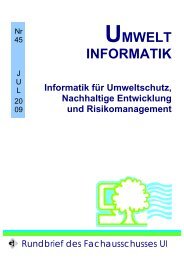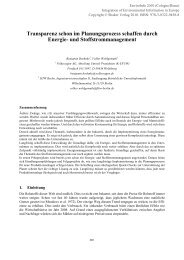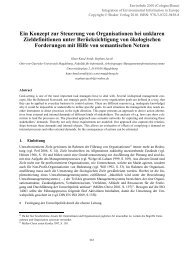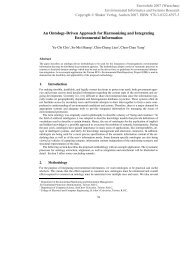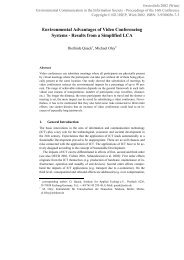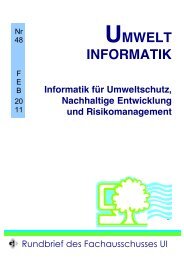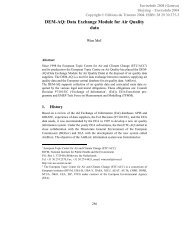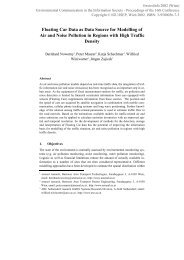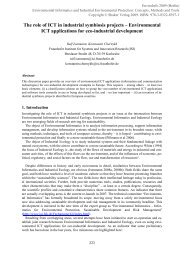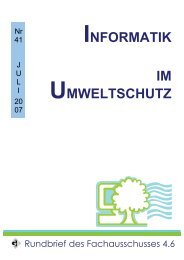the Case of Life Cycle Inventories - EnviroInfo
the Case of Life Cycle Inventories - EnviroInfo
the Case of Life Cycle Inventories - EnviroInfo
You also want an ePaper? Increase the reach of your titles
YUMPU automatically turns print PDFs into web optimized ePapers that Google loves.
<strong>EnviroInfo</strong> 2011: Innovations in Sharing Environmental Observations and InformationCopyright 2011 Shaker Verlag Aachen, ISBN: 978-3-8440-0451-9Integrating ERP and Environmental Information Systems – <strong>the</strong><strong>Case</strong> <strong>of</strong> <strong>Life</strong> <strong>Cycle</strong> <strong>Inventories</strong>Marcel Severith 1 , Lorenz M. Hilty 2AbstractThis paper takes <strong>the</strong> life cycle inventory database ecoinvent as an example <strong>of</strong> <strong>the</strong> integration <strong>of</strong> ERP and environmentalinformation systems. A reference model describes <strong>the</strong> ERP-integrated creation <strong>of</strong> life cycle assessments basedon ecoinvent data. The main challenges to implement <strong>the</strong> reference model from <strong>the</strong> viewpoint <strong>of</strong> ecoinvent are identifiedand approaches for a solution presented. First, an outline for an ontology enhancing ecoinvent metadata is givento help bridge <strong>the</strong> so-called semantic gap. Second, <strong>the</strong> basic web services needed to attach to a service-oriented architectureare described.1. Introduction1.1 Motivation for environmental managementRespecting environmental limits and using energy and raw materials more efficiently can bring considerablecost savings. It can also help an enterprise gain competitive advantages especially with politicians and<strong>the</strong> public calling for more ecological products and services (Beucker 2000, 323-324).However, ecological aspects are not always a priority <strong>of</strong> top management, although management mayclaim o<strong>the</strong>rwise. In reality, <strong>of</strong>ten only compliance with environmental legislation is monitored instead <strong>of</strong>preventing environmental damages strategically (Junker 2010). Not even risk management takes any realnotice yet <strong>of</strong> environmental information (Funk/Möller/Niemeyer 2007).One reason for this disregard is inadequate IT support. So-called environmental management informationsystems (EMIS) are meant to support companies in matters <strong>of</strong> environmental protection (Hilty &Rautenstrauch 1997; Hilty 2000). Unfortunately <strong>the</strong>se systems are <strong>of</strong>ten isolated solutions, each solvingsubtasks only. If at all, <strong>the</strong>y are coupled only loosely to o<strong>the</strong>r enterprise information systems (ERP), whichare <strong>of</strong> central importance for modern businesses (Junker 2010; Teuteberg/Gómez 2010, 7-11).Therefore, integrating means <strong>of</strong> environmental assessment into ERP systems can be regarded as an importantstep towards holistically incorporating environmental limits into operative and strategic decisionprocesses.1.2 Integrating environmental data into ERP – state <strong>of</strong> <strong>the</strong> artThe central challenge <strong>of</strong> integrating environmental assessment appears to be expanding <strong>the</strong> ERP masterdata. Normally ERP does not contain any environmental information at all. Fur<strong>the</strong>rmore data is <strong>of</strong>ten not1 Empa Material Science and Technology, Lerchenfeldstrasse 5, CH-9014 St. Gallen, marcel.severith@online.de2 Informatics and Sustainability Research (ISR), University <strong>of</strong> Zurich, Binzmuehlestr. 14, CH-8050 Zurich, and Empa MaterialScience and Technology, Lerchenfeldstrasse 5, CH-9014 St. Gallen, lorenz.hilty@empa.ch
as detailed as necessary for environmental assessment (Eul/Rey 2000, 214-222; Isenmann/Rautenstrauch2007, 76-79).Various studies have presented how environmental data could be integrated into ERP systems. Someare general models (Lang-Koetz/Heubach 2007), some concrete case studies on systems like infor:COM(Eul/Rey 2000) and SAP (Kuhrke/Feickert et al. 2008; Funk/Gómez et al. 2010).However, none <strong>of</strong> <strong>the</strong>se studies pay close attention to <strong>the</strong> source <strong>of</strong> environmental data. Often a vagueexplanation is given that data have been supplied by an EMIS, a web service or manual input. In <strong>the</strong> following,<strong>the</strong>refore, we describe what it looks like to acquire data from an environmental information systemtaking ecoinvent as an example.1.3 <strong>Life</strong> <strong>Cycle</strong> Assessment with ecoinvent<strong>Life</strong> <strong>Cycle</strong> Assessment (LCA) is a standardized method for estimating <strong>the</strong> environmental impacts <strong>of</strong> productsand services. Therefore material and energy flows occurring along <strong>the</strong> whole life cycle are counted inrelationship to <strong>the</strong> product output (Klöpffer/Grahl 2009, 1-4). LCA is not explicitly concerned with managementstructures or environmental plans (Krcmar/Dold et al. 2000, 15-16). However, an LCA can providea prerequisite for environmental management, i.e. by identifying crucial factors for environmentalimprovements.Within LCA <strong>the</strong>re is <strong>of</strong>ten a lack <strong>of</strong> information regarding material and energy flows. While an enterprisemay get specific data for some <strong>of</strong> its own activities, <strong>the</strong> environmental impacts <strong>of</strong> o<strong>the</strong>r own activitiesas well as impacts <strong>of</strong> upstream product chains have to be estimated with <strong>the</strong> help <strong>of</strong> generic backgrounddata (Klöpffer/Grahl 2009, 125-134).ecoinvent is one <strong>of</strong> <strong>the</strong> world’s leading databases for generic life cycle inventory data. With its comprehensivebasis <strong>of</strong> over 4000 datasets (Frischknecht/Jungbluth et al. 2005; Klöpffer/Grahl 2009, 138-139;Hilty 2008, 137-138) ecoinvent can serve as a basis for LCA in cases where <strong>the</strong>re is no specific data available.1.4 Steps towards an integration <strong>of</strong> ERP and ecoinventThe reference model depicted here describes <strong>the</strong> ERP-integrated creation <strong>of</strong> a simplified LCA with <strong>the</strong>help <strong>of</strong> ecoinvent. It is based on <strong>the</strong> model <strong>of</strong> Funk/Möller/Niemeyer (2009). The model assumes that <strong>the</strong>ERP is <strong>the</strong> leading corporate information system and thus also responsible for <strong>the</strong> process <strong>of</strong> LCA. Supportingsystems like ecoinvent are integrated with <strong>the</strong> help <strong>of</strong> a service-oriented architecture (SOA).Previous studies presented how environmentally relevant activities can be retrieved from <strong>the</strong> ERP masterdata; see for example Eul/Rey 2000; Isenmann/Rautenstrauch 2007; Kuhrke/Feickert et al. 2008;Funk/Niemeyer 2010. In addition, supplier-specific data can be used whenever it is available. Even downstreamactivities can be taken into account with <strong>the</strong> help <strong>of</strong> representative data and assumptions.Thus we argue that <strong>the</strong> ERP can determine all relevant activities occurring throughout <strong>the</strong> life cycle <strong>of</strong><strong>the</strong> given product. However, <strong>the</strong> environmental impacts <strong>of</strong> <strong>the</strong> activities remain unknown for <strong>the</strong> ERP.Therefore ecoinvent is used to ga<strong>the</strong>r <strong>the</strong> appropriate data and integrate it into <strong>the</strong> ERP.For that <strong>the</strong> ERP activities have to be mapped to <strong>the</strong> activities represented in ecoinvent first. Thus far, ithas not been possible to automatically collate data as part <strong>of</strong> a generic solution. Instead this task requires alot <strong>of</strong> manual intervention and expert knowledge. The precise mapping <strong>of</strong> activities is hindered by differentmethodical assumptions and <strong>the</strong> lack <strong>of</strong> a common vocabulary. This problem is called <strong>the</strong> semanticgap. It has previously been identified as <strong>the</strong> biggest single challenge for an automated life cycle assessmentby Funk/Möller/Niemeyer (2009).Copyright 2011 Shaker Verlag Aachen, ISBN: 978-3-8440-0451-9
1. The activities in <strong>the</strong> ERP system and in ecoinvent are described in a different terminology.2. The abstraction levels at which <strong>the</strong> activities are represented are different in each system. The environmentaleffects <strong>of</strong> an ERP activity may be described by multiple activity datasets in ecoinvent.2.1 Existing metadata in ecoinventecoinvent provides extensive metadata that is expected to enable proper application <strong>of</strong> <strong>the</strong> data. Most informationis provided in <strong>the</strong> form <strong>of</strong> free text. According to Bisch<strong>of</strong>/Bauer-Messmer (2008) it is easy forexperts to input free text information. However, this form <strong>of</strong> representation hinders automatic processingas well as <strong>the</strong> understanding <strong>of</strong> users who lack <strong>the</strong> specialized terminology.However, some metadata is semantically <strong>of</strong> particular interest already. A rudimentary taxonomy can bederived from <strong>the</strong> dataset structure <strong>of</strong> <strong>the</strong> current ecoinvent v2. The activities are categorized according to aproprietary scheme. It distinguishes among <strong>the</strong> <strong>the</strong>matic areas depicted in Figure 2.Figure 2Top level <strong>of</strong> <strong>the</strong> current classification for ecoinvent activitiesIn ecoinvent v3, anticipated for release in mid-2012, it is intended to classify <strong>the</strong> activities on <strong>the</strong> basis <strong>of</strong><strong>the</strong> ISIC standard (International Standard Industrial Classification). This standard defines a universal classificationfor economic activities. The restructuring makes sense from an organizational standpoint, as <strong>the</strong>Editorial Board responsible for quality control is also structured in conformity to <strong>the</strong> ISIC standard(ecoinvent Centre n.d.).However, <strong>the</strong> contents <strong>of</strong> <strong>the</strong> individual activities can only be distinguished fur<strong>the</strong>r by <strong>the</strong>ir name and<strong>the</strong>ir free text documentation. An explicit differentiation on <strong>the</strong> basis <strong>of</strong> <strong>the</strong> existing or upcoming classificationis not possible.Copyright 2011 Shaker Verlag Aachen, ISBN: 978-3-8440-0451-9
Figure 3Top level <strong>of</strong> ISIC classification (United Nations 2008, 43)2.2 Introducing a new classification <strong>of</strong> activitiesIn contrast to that, <strong>the</strong> semantics proposed here takes into account <strong>the</strong> various types <strong>of</strong> ecoinvent activities.Some <strong>of</strong> <strong>the</strong> conditions <strong>of</strong> <strong>the</strong> individual activities vary quite a lot, making an exact categorization <strong>of</strong> <strong>the</strong>activities extremely challenging. Never<strong>the</strong>less <strong>the</strong>y can be subdivided into <strong>the</strong> following four main groups.providing a product: most <strong>of</strong> <strong>the</strong> ecoinvent activities describe <strong>the</strong> providing <strong>of</strong> products (goods and services).For example, this type includes activities describing <strong>the</strong> extraction <strong>of</strong> raw materials, <strong>the</strong> production<strong>of</strong> components or <strong>the</strong> supply <strong>of</strong> electric energy. In some cases multiple activities describe providing sameor similar products under different conditions and thus varying environmental impacts. In <strong>the</strong> case <strong>of</strong> rawmaterials, for instance, a distinction is made between primary raw materials and recycled secondary rawmaterials. Activities may already contain product losses, activities <strong>of</strong> wholesale and retail dealers as wellas transport and disposal activities. In addition to <strong>the</strong> production <strong>of</strong> tangible goods providing a service fallsinto this category as well. Services can be recognized by <strong>the</strong> dimensions in which <strong>the</strong>y are commerciallymeasured. Whereas quantities <strong>of</strong> tangible goods are specified in pieces or physical mass, services are definedin a variety <strong>of</strong> o<strong>the</strong>r dimensions, such as distances, work or time.Copyright 2011 Shaker Verlag Aachen, ISBN: 978-3-8440-0451-9
processing a product: such activities describe <strong>the</strong> processing <strong>of</strong> products; especially in <strong>the</strong> area <strong>of</strong> rawmaterials. Normally such an activity contains only <strong>the</strong> environmental impacts <strong>of</strong> processing, but not <strong>the</strong>environmental impacts <strong>of</strong> providing <strong>the</strong> product under study.disposal <strong>of</strong> a product: this type describes <strong>the</strong> environmental impact caused by disposing a product underspecified conditions. This means in particular <strong>the</strong> type <strong>of</strong> disposal (incineration or landfill).transport: transport, in deviation from <strong>the</strong> preceding methods, is usually not defined for specific products,but generically. Instead environmental impacts <strong>of</strong> transportation are defined as a function <strong>of</strong> transportmeans, distance and weight.2.3 Introducing <strong>the</strong> concept <strong>of</strong> <strong>the</strong> productAll activities represented in ecoinvent, with <strong>the</strong> exception <strong>of</strong> transport activities, refer to <strong>the</strong> concept <strong>of</strong> <strong>the</strong>product. However, until now <strong>the</strong>re has been no explicit mention <strong>of</strong> “product” in <strong>the</strong> database. Therefore letus provide an introduction in <strong>the</strong> following.A <strong>the</strong>saurus is used to define synonyms and relations between broader and narrower terms within a givendomain. The use <strong>of</strong> an existing <strong>the</strong>saurus to classify products would be an advantage. However Bisch<strong>of</strong>/Bauer-Messmer(2008) have judged that services such as <strong>the</strong> <strong>the</strong>saurus GEMET are unsatisfactory onaccount <strong>of</strong> its poor data quality. As for <strong>the</strong> German language, <strong>the</strong>re is also <strong>the</strong> Semantic Network Service(SNS), which serves as a reference for systems <strong>of</strong> <strong>the</strong> Federal German Government (Rü<strong>the</strong>r/Bandholtz2008).Many useful <strong>the</strong>sauri cover quite a narrow domain. In contrast ecoinvent claims to thoroughly cover <strong>the</strong>environmental impacts <strong>of</strong> providing goods and services as completely as possible. This requires semanticinformation across all economic areas.Domain-independent data sources play an important role for <strong>the</strong> requisite connection <strong>of</strong> various datasources into a coherent network. One well-known example <strong>of</strong> that is <strong>the</strong> Project DBpedia, which providesstructural data extracted from Wikipedia (Bizer/Becker 2010). Semantic processes can be improved with<strong>the</strong> large Wikipedia database. The individual Wikipedia articles have <strong>the</strong>ir own metastructure; <strong>the</strong> articlesare linked logically with o<strong>the</strong>rs and usually are even categorized. Fur<strong>the</strong>rmore, Wikipedia is extremely efficientin solving word forms having multiple meanings (Gillmeier/Hengartner/Pedrazzini 2010).A first version <strong>of</strong> an extensive <strong>the</strong>saurus can be made on <strong>the</strong> basis <strong>of</strong> categorizations in Wikipedia(Gillmeier/Hengartner/Pedrazzini 2010). However, it has to be expected that fur<strong>the</strong>r manual interventionwill be needed to satisfy specific requirements.2.4 Introducing an ontology for ecoinventAn ontology is a descriptive model representing <strong>the</strong> basic concepts, relations and constraints used to describea given domain. It is shared by a group <strong>of</strong> people who want to exchange knowledge about <strong>the</strong> domain(Aßmann/Zschaler/Wagner 2006, 255-257). The ontology presented here is intended to serve as asemantic complement to <strong>the</strong> metadata existing in ecoinvent, bridging <strong>the</strong> semantic gap between ecoinventand <strong>the</strong> ERP. The following aspects are transparent in particular:1. ecoinvent activities are put into <strong>the</strong> predefined categories.2. The product concept is introduced and made semantically useful with <strong>the</strong> aid <strong>of</strong> a <strong>the</strong>saurus. Referringto a DBpedia entity accomplishes an unequivocal definition <strong>of</strong> a class <strong>of</strong> products.3. Products and activities are brought into connection with each o<strong>the</strong>r.Copyright 2011 Shaker Verlag Aachen, ISBN: 978-3-8440-0451-9
Figure 4Approach <strong>of</strong> an ontology for semantic enhancement <strong>of</strong> ecoinvent dataThe ontology makes it possible to take a product and to identify all corresponding ecoinvent activities forproviding, processing and disposing it. In addition, suitable transport activities can be inferred from <strong>the</strong>physical properties <strong>of</strong> <strong>the</strong> product. In some cases multiple activities may exist per category that can be distinguishedby <strong>the</strong>ir properties.Under <strong>the</strong> assumption that <strong>the</strong> entity <strong>of</strong> <strong>the</strong> product and <strong>the</strong> type <strong>of</strong> activity can be identified in <strong>the</strong> ERP,mapping activities between ERP and ecoinvent becomes much easier. However, <strong>the</strong> following challengeshave not yet been solved satisfactorily by <strong>the</strong> ontology:1. The atomicity <strong>of</strong> products is still work in progress. We assume a certain abstraction level with ourproduct concept. This means that similar products with different properties are collected under oneproduct. “Aluminum” thus means a raw material independently <strong>of</strong> whe<strong>the</strong>r it was manufactured asprimary raw material or secondary raw material.2. For <strong>the</strong> unequivocal identification <strong>of</strong> activities <strong>the</strong>ir properties are to be defined exactly. These dependon both <strong>the</strong> activity category and <strong>the</strong> type <strong>of</strong> product. For example, in <strong>the</strong> case <strong>of</strong> raw materials, a distinctionis made between primary or secondary raw materials, whereas agrarian products are classifiedaccording to cultivation methods. The difficulty exists here in <strong>the</strong> exact classification <strong>of</strong> products. Asecoinvent describes <strong>the</strong> “whole world” <strong>of</strong> tradable products, classification systems <strong>of</strong> specific disciplinessoon reach <strong>the</strong>ir limits. Therefore designing a master system <strong>of</strong> classification is quite difficult.3. The ontology describes only activities that are defined in ecoinvent. The ontology <strong>the</strong>refore naturallyhits its limits whenever activities are lacking for specific products or product properties. For example,Copyright 2011 Shaker Verlag Aachen, ISBN: 978-3-8440-0451-9
<strong>the</strong>re is no product defined such as an “aluminum capsule“. The ontology makes it easier to assemble“aluminum, primary, at plant” and “sheet rolling, aluminum” to an “aluminum capsule, <strong>of</strong> primary rawmaterial”; but <strong>the</strong> links have to be made manually. The decision to include such an activity in ecoinventand thus in <strong>the</strong> ontology may be justified by <strong>the</strong> existence <strong>of</strong> sufficient demand for such activities. Ultimately,though, <strong>the</strong> decision is made by <strong>the</strong> Editorial Board <strong>of</strong> ecoinvent.3. Attaching to a service-oriented architecture (SOA)Hansen/Neumann (2009, 664-665) speak <strong>of</strong> a trend toward modularization through service-oriented architecture(SOA) in ERP systems. A SOA <strong>of</strong>fers prepackaged services via standardized interfaces, and thusimproves linking <strong>of</strong> various applications. Therefore a SOA is also advisable for integrating ecoinvent inERP systems. The required services can be identified with <strong>the</strong> help <strong>of</strong> <strong>the</strong> reference model describedabove.3.1 Services to bridge <strong>the</strong> semantic gapAn important service for bridging <strong>the</strong> gap is getting a list <strong>of</strong> semantically related ecoinvent activities basedon ERP data. This service accesses <strong>the</strong> predefined ontology. In addition to mapping <strong>the</strong> activity object,unit <strong>of</strong> measurement and geographic space also have to be determined. We argue, however, that <strong>the</strong>sechallenges are much easier to solve. As long as <strong>the</strong> automatic mapping is not sufficiently reliable, <strong>the</strong> usercan be <strong>of</strong>fered similar activities for manual verification in a semi-automatic process. On <strong>the</strong> long term anautomatic correspondence can be set up by this service.After manual verification, <strong>the</strong>re may be a need to extend <strong>the</strong> ontology or even <strong>the</strong> ecoinvent database. Inthis way <strong>the</strong> future mapping <strong>of</strong> similar activities can be facilitated. Thus a service should also report <strong>the</strong>parameters <strong>of</strong> <strong>the</strong> mapping back to ecoinvent. One could think into <strong>the</strong> direction <strong>of</strong> “user generated content”and “collective intelligence” known from so-called Web 2.0 applications. Such an approach wouldbe quite new for <strong>the</strong> review-based working method <strong>of</strong> <strong>the</strong> Editorial Board <strong>of</strong> ecoinvent. But a smooth integration<strong>of</strong> such new elements could help enhance <strong>the</strong> practical usefulness <strong>of</strong> ecoinvent.3.2 Services for getting environmental dataAt present ecoinvent provides its data in <strong>the</strong> EcoSpold format on <strong>the</strong> basis <strong>of</strong> XML. The XML file can beimported and post-processed by third-party s<strong>of</strong>tware (Frischknecht/Jungbluth et al. 2005). Until now, ithas still been necessary to select and download <strong>the</strong> files from <strong>the</strong> ecoinvent Website. This functionalitycan, however, be transformed into a service. This service can easily provide environmental data for individualactivities in <strong>the</strong> following levels <strong>of</strong> detail:1. cumulative results <strong>of</strong> life cycle inventory, a list <strong>of</strong> all environmental flows2. cumulative results <strong>of</strong> life cycle assessment, based on various impact assessment methodsAdditionally a service doing <strong>the</strong> impact assessment based on a life cycle inventory composed outside <strong>of</strong>ecoinvent may be useful. Thus <strong>the</strong> step <strong>of</strong> getting inventory data would not be solely dependent on ecoinvent.This would allow integrating o<strong>the</strong>r data sources as well.For all <strong>the</strong>se services <strong>the</strong> EcoSpold format is sufficient. In order to fur<strong>the</strong>r <strong>the</strong> idea <strong>of</strong> a simplified LCA,however, an adaption <strong>of</strong> EcoSpold should be considered. Until now, EcoSpold <strong>of</strong>fers only multiple methods<strong>of</strong> impact assessment at once. Given <strong>the</strong> fact that only one is usually needed, <strong>the</strong> desired method couldbe specified as a parameter. That would facilitate <strong>the</strong> data storage in ERP.Copyright 2011 Shaker Verlag Aachen, ISBN: 978-3-8440-0451-9
4. Conclusions and outlookWe presented a reference model for <strong>the</strong> ERP-integrated creation <strong>of</strong> simplified LCA. The model does notpresuppose <strong>the</strong> existence <strong>of</strong> any dedicated environmental management information system (EMIS). Instead<strong>the</strong> life cycle inventory database ecoinvent provides data about <strong>the</strong> environmental impacts <strong>of</strong> corporateactivities. The data can <strong>the</strong>n be post-processed in <strong>the</strong> ERP.This paper describes work required on <strong>the</strong> ecoinvent side to implement <strong>the</strong> reference model. That workconsists mainly <strong>of</strong> bridging <strong>the</strong> semantic gap and providing web services to attach to a service-oriented architecture.The web services needed for ERP integration have been described roughly. They serve both to map activitiesand to obtain environmentally relevant data. As for <strong>the</strong> services to obtain <strong>the</strong> environmentally relevantdata, one can for <strong>the</strong> most part fall back on <strong>the</strong> implemented functionality and <strong>the</strong> internationally renowneddata format EcoSpold.For bridging <strong>the</strong> semantic gap we suggest to perform a semantic enrichment <strong>of</strong> ecoinvent data. Firststeps towards an ontology have been described. One <strong>of</strong> <strong>the</strong>m is to introduce <strong>the</strong> concept <strong>of</strong> a product, ano<strong>the</strong>ris to classify activities by <strong>the</strong>ir types and a third brings activities and products into connection wi<strong>the</strong>ach o<strong>the</strong>r. The ontology we have presented makes it possible to see <strong>the</strong> broad outlines <strong>of</strong> a semanticsearch function. With semantic search <strong>the</strong> results can be improved in comparison with a purely text-basedsearch. Due to a few still open questions, enjoying completely automatic mapping remains a distant perspective.However, one can assume that <strong>the</strong> ontology will at least facilitate <strong>the</strong> manual collation <strong>of</strong> activities.Whe<strong>the</strong>r <strong>the</strong> ontology is feasible can only be verified using case studies. We expect that adaptations andexpansions derived from practical experience will be necessary. For that, it appears promising to derivegeneral requirements for semantics from different business sectors. Investigating multiple sectors will helpto draw domain-independent conclusions.BibliographyAßmann, U., Zschaler, S., Wagner, G. (2006): Ontologies, Meta-models, and <strong>the</strong> Model-Driven Paradigm,in: C. Calero et al. (eds.): Ontologies for S<strong>of</strong>tware Engineering and S<strong>of</strong>tware Technology, BerlinHeidelberg, pp. 249-273Beucker, S. (2000): Umweltinformationen - entscheidender Faktor für den Unternehmenserfolg, in: H.J.Bullinger et al. (eds.): Auftragsabwicklung optimieren nach Umwelt- und Kostenzielen, Berlin Heidelberg,pp. 323-331Bisch<strong>of</strong>, S., Bauer-Messmer, B. (2008): Semantic Enhancement <strong>of</strong> Environmental Metadata, in: A. Mölleret al. (eds.): Environmental Informatics and Industrial Ecology. 22th International Conference onInformatics for Environmental Protection. <strong>EnviroInfo</strong> 2008, Aachen, pp. 123-131Bizer, C., Becker, C. (2010): Semantische Mashups auf Basis des Linked Data Web, in: U. Hengartner, A.Meier (eds.): Web 3.0 & Semantic Web, HMD, Heft 271, Heidelberg, pp. 59-69ecoinvent Centre (n.d.): Editorial Board, http://www.ecoinvent.org/organisation/editorial-board/, last access:22. July 2011Eul, D., Rey, U. (2000): Einführung von umweltorientierten Funktionalitäten in ERP-Systemen, in: H.J.Bullinger et al. (eds.): Auftragsabwicklung optimieren nach Umwelt- und Kostenzielen, Berlin Heidelberg,pp. 205-225Frischknecht R., Jungbluth N., Althaus H.J., Doka G., Dones R., Heck T., Hellweg S., Hischier R.,Nemecek T., Rebitzer G., Spielmann M. (2005) The ecoinvent database: Overview and MethodologicalFramework, International Journal <strong>of</strong> life cycle assessment, Vol. 10, No. 1, pp. 3-9Copyright 2011 Shaker Verlag Aachen, ISBN: 978-3-8440-0451-9
Funk, B., Gómez, J.M., Niemeyer, P., Teuteberg, F. (2010): Geschäftsprozessintegration mit SAP. Fallstudienzur Steuerung von Wertschöpfungsprozessen entlang der Supply Chain, Berlin HeidelbergFunk, B., Möller, A., Niemeyer, P. (2009): A reference architecture for <strong>the</strong> integration <strong>of</strong> EMIS and ERPsystems,in: Lecture Notes in Informatics, 154, pp. 3393-3401Funk, B., Möller, A., Niemeyer, P. (2007): Integration <strong>of</strong> Risk-Oriented Environmental Management InformationSystems and Resource Planning Systems. In: O. Hryniewicz et al. (eds.): Environmentalinformatics and systems research, Band 1, Aachen, pp. 545-552Funk, B., Niemeyer, P. (2010): Abbildung von Umweltwirkungen in betrieblichen Informationssystemen,in: J.M. Gómez et al. (eds.): Green Computing & Sustainability, HMD, Heft 274, Heidelberg, pp.37-46Gillmeier, S., Hengartner, U., Pedrazzini, S. (2010): Wie man mit der Wikipedia semantische Verfahrenverbessern kann, in: U. Hengartner, A. Meier (eds.): Web 3.0 & Semantic Web, HMD, Heft 271,Heidelberg, pp. 70-80Hansen, H.R., Neumann, G. (2009): Wirtschaftsinformatik 1. Grundlagen und Anwendungen, StuttgartHilty, L.M. (2008): Information technology and sustainability. Essays on <strong>the</strong> relationship between ICTand sustainable development, NorderstedtHilty, L. M. (2000): Umweltinformationen strategisch und betriebsübergreifend nutzen, in: A.B. Cremers,K. Greve (eds.): Umweltinformation für Planung, Politik und Öffentlichkeit, Umweltinformatik aktuell,Band 26, Marburg, pp. 716-722Hilty, L. M., Rautenstrauch, C. (1997): Environmental Information Systems for Production and Recycling,in: D. Swayne et al. (eds.): 2nd International Symposium on Environmental S<strong>of</strong>tware Systems(ISESS), New York, pp. 21-29Isenmann, R., Rautenstrauch, C. (2007): Horizontale und vertikale Integration Betrieblicher Umweltinformationssysteme(BUIS) in Betriebswirtschaftliche Anwendungsszenarien, in: uwf, Vol. 15, No.2, pp. 75–81Junker, H. (2010): Die Beliebigkeit betrieblicher Umweltinformationssysteme - eine Polemik, in: K. Greve,A.B. Cremers. (eds.): Integration <strong>of</strong> Environmental Information in Europe. <strong>EnviroInfo</strong> 2010,Köln Bonn, Aachen, pp. 232-247Klöpffer, W., Grahl, B. (2009): Ökobilanz (LCA). Ein Leitfaden für Ausbildung und Beruf, WeinheimKrcmar, H., Dold, G., Fischer, H., Strobel, M., Seifert, E.K. (2000): Informationssysteme für das Umweltmanagement.Das Referenzmodell ECO-Integral, München WienKuhrke, B., Feickert, S., Stöcker, P., Melk, K., Clesle, F.D., Bachmann, E. (2008): <strong>Life</strong> <strong>Cycle</strong> Design aufBasis von Standards<strong>of</strong>twaresystemen, in: E. Abele et al. (eds.): EcoDesign. Von der Theorie in diePraxis, Berlin Heidelberg, pp. 149-184Lang-Koetz, C., Heubach, D. (2007): Umweltcontrolling umsetzen - Erstellung von Kennzahlen für St<strong>of</strong>fundEnergieströme und deren Integration in die betriebliche IT, StuttgartRü<strong>the</strong>r, M., Bandholtz, T. (2008): Semantic Network Service (SNS) Update and Future Vision, in: A.Möller et al. (eds..): Environmental Informatics and Industrial Ecology. 22th International Conferenceon Informatics for Environmental Protection. <strong>EnviroInfo</strong> 2008, Aachen, pp. 401-408Teuteberg, F., Gómez, J.M. (2010): Green Computing & Sustainability. Status quo und Herausforderungenfür betriebliche Umweltinformationssysteme der nächsten Generation, in: J.M. Gómez et al.(eds.): Green Computing & Sustainability, HMD, Heft 274, Heidelberg, pp. 6-17United Nations (eds.) (2008): International Standard Industrial Classification <strong>of</strong> All Economic Activities,Revision 4, Statistical papers, New YorkCopyright 2011 Shaker Verlag Aachen, ISBN: 978-3-8440-0451-9






